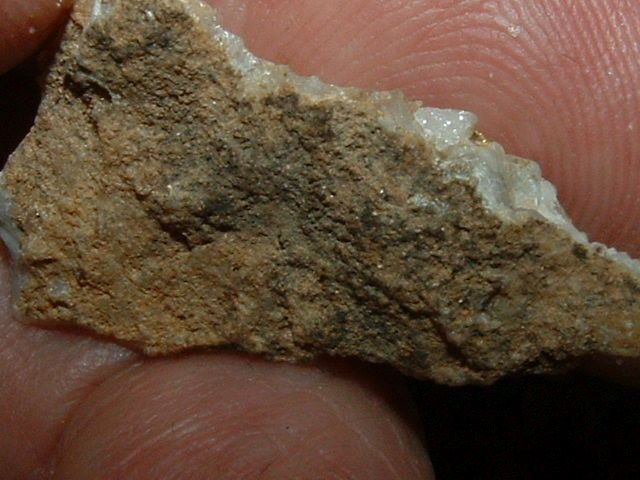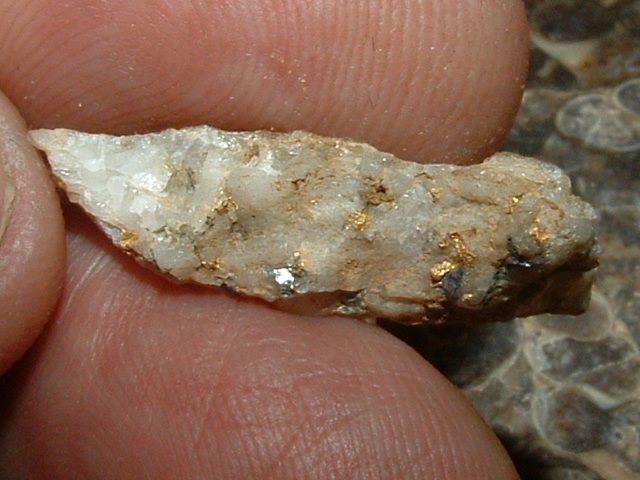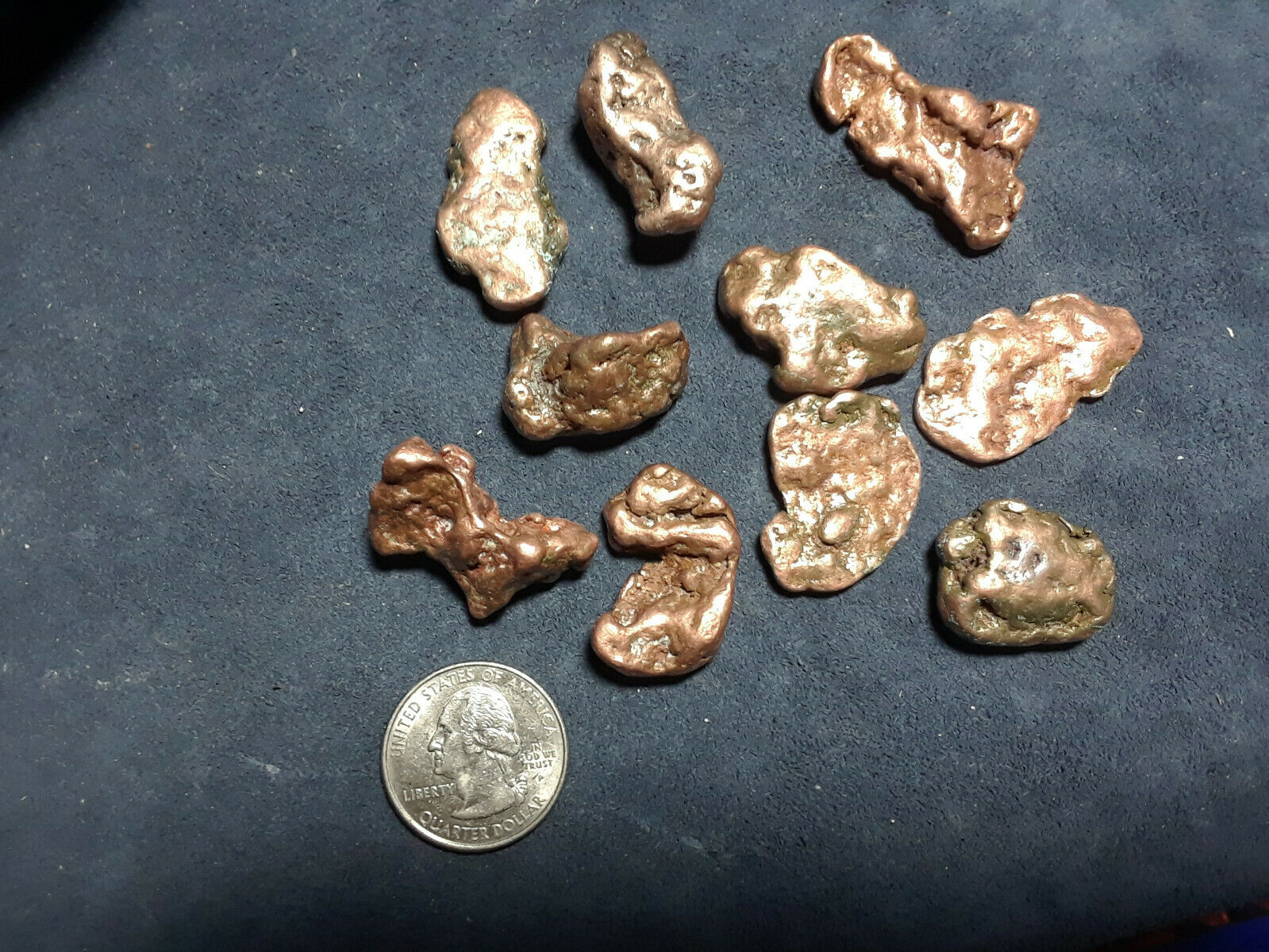-40%
GOLD CALCITE SPECIMEN 2.63 GRAM NATURAL CALIFORNIA GOLD AND QUARTZ
$ 34.32
- Description
- Size Guide
Description
NATIVE GOLD QUARTZ SPECIMENfrom the
MOTHER LODE
R
uler is
1/4"
wide (6 mm). U.S. 10 cent coin is 17 mm in diameter.
S
pecimen weight:
2.63
G
ram -
40.7
G
rains
S
ize:
26.8X15.6X7.7
mm
W
hite silicate rock, a banded calcite-carbonate-quartz, plays host to several exposures of high-purity, 'goldilocks' gold. If you're dubious, just remember, this comes from California's Mother Lode where, seemingly, no limit exists in number of diverse ores encountered throughout this crazy-rich cordillera. True collectors need this one. Again, we enter into the mystical, metallurgical realm of GOLD! Amongst countless mineral associations occurring in nature, this is but one. In my book, the most exciting discipline of all. There's no need for a pocket lens to see the gold protruding from this calcitic artifact. One side shows a dark, concretionary coating. Featured specimen was Born-in-the-U.S.A. and is naturally-occurring. I guarantee it.
All my rocks show visible gold and are
authentic
.
I don't sell low grade gold ores. I sell naturally-occurring gold quartz ores with visible gold. Most are from the U.S. These high-grade beauties are expensive to obtain and even harder to find. Prices aren't based upon the amount of gold contained, but on the authenticity, rarity and collectability of specimens.
U.S. SHIPPING - .00
(includes USPS tracking to all U.S. destinations)
INTERNATIONAL CUSTOMERS S&H
.00
FAST REFUND OFFERED
(If, for any reason, you're not happy with this item)
For years, I poured through old mining dumps inspecting orange-yellow-rust rock through a loupe. In all that time, I never found a solitary piece with visible gold. Doesn't that seem strange to you? It does to me, law of averages and all. Oh yeah! Tell me how easy it is to find gold. It's not! That's the reality of it, and yet, having spent eighteen years in the placer fields of North American, I still believe a person 'in the know' stands a respectable chance of hitting minable gold deposits provided they have the proper tools and the right claim.
Hydrothermal solutions carried gold and silica into fissures. As they cooled, these minerals hardened (i.e. crystallized) and gold veins came to be. That's how gold quartz, as it is known, is created. The specimen offered here comes from one of the many vein systems sourcing the immense placer deposits of the Sierra Nevada Mtns, the famed Mother Lode.
Weight Conversions:
15.43 GRAINS = 1 GRAM
31.103 GRAMS = 1 TROY OUNCE
24 GRAINS = 1 PENNYWEIGHT (DWT)
20 DWT = 1 TROY OUNCE
480 GRAINS = 1 TROY OUNCE
S & H
Discounted for combined shipments.
U.S. BUYERS & INTNL.
PAYMENTS
For U.S. buyers: We accept paypal
For intnl. customers: We accept paypal.
Pay securely with
www.paypal
.
Payment must be made within 7 days from close of auction. We ship as soon as funds clear. If you have questions, please ask them before bidding.
REFUNDS
We leave no stones unturned insuring our customers get what they bargained for.
If you're not satisfied with this item, contact me. Then, if the problem can't be fixed, return product within 30 days in 'as purchased' condition for a full refund
OPENING UP A HOLE
T
oo much overburden is one of a gold dredger's biggest disappointments. If you can't reach bedrock to test it, you've pretty much wasted your resources and time. A lot about dredging in a large river (or creek) depends upon the mining history of an area or an operator's hunches. Did I mention the role good luck plays? I figure chance favors the guy who likes to dig like a gopher - the dredger with no quit in him, the one prepared to punch hole after hole until he finds what he's after is the one who ultimately meets with success. Just ask 'Chile Joe'. He'll tell you about 'true grit'. When there's countless feet of gravel to penetrate, one has to believe they're in the right spot before committing to a hole which could possibly take days of sucking gravel before bedrock is ever reached. Confronted with twenty feet of overburden means terracing off large expanses of sediment. Once a layer is removed, a diver, the guy holding the nozzle, proceeds on down to the next layer and so on and so forth. Upon reaching bottom, this method of excavation eventually allows enough bedrock to be exposed so that any meandering paystreak inhabiting that section of the creek or river-bottom might ultimately be intersected. It's easy to miss a paystreak entirely even with one close by. Punching your nozzle into the gravel and heading towards the bottom quickly reveals the pitfalls of such ill-advised dredging techniques. Just watch the Gold Rush dredger blokes who will demonstrate exactly what I mean. How many times have we seen them break the cardinal rule of 'safety first' in developing one of their numerous excavations? You'd think they might have learned something by now. Of course, there's "a million dollars worth of gold down there" so everybody's in a big hurry to see what's on bedrock. I figure, by throwing caution to the wind, we ( the show's producers) have created more drama, greater excitement, and unbearable suspense. It's dumb and dangerous, plain and simple. 'Stupid is as stupid does."
Count on overburden to hold minimal gold, but you've really no choice but to pump all that barren dirt. Even when a hole is developed by the terracing method, there's no guarantee a paystreak's going to be waiting on bedrock. If you know what's good for you, don't work below boulders my friends. That's a careless recipe for disaster. A personal friend had his leg broken when a boulder plummeted down from behind him.
B
oulders oftimes are encountered at or near bedrock. In narrow creeks, you're more likely to encounter boulders from top to bottom throughout the sedimentary strata. They're also hanging suspended from embankments waiting for something to jar them loose from loose sand and tangled root-systems. Boulders come in all sizes, shapes, weights, and compositions. Many times, good, paying ground awaits in their proximity. At the same time, boulders are a miner's nemesis. When they're suspended, you've that constant reminder of just how dangerous gold dredging can be. But this is gold mining. Historically, miners are known to tackle just about any kind of adversity or obstacle to get at the gold.
Many of these big rocks concentrated down on bedrock can be nudged out of the way with a pry bar. Many can't. Using a come-a-long or powered winch, you generally need to open up space around bigger rocks so a choker cable can be secured. Nowadays, I see they've designed super-claws which clamp onto boulders which are then high-lined or winched away. Pretty cool concept, really. Did I mention how dangerous boulders high in the overburden or suspended above you are? I thought so. If you have a powered winch, yank them out of the hole and try to drag them some distance from your excavation. Whatever you do, always stay on top of the boulders, not the other way around. If you're in good gold, it's definitely advisable to keep your hole and working face clear of larger rocks. With many miners, the discovery of gold sets off an instinctual shark-feeding-frenzy. It's advisable to keep one's emotions in check and proceed cautiously, safely. Conditions are rarely the same from one dredge site to the next, from one drainage to another. Be careful, mates. Dredging is dangerous work.
Welcome to the wild world of gold mining!
Thanks for checking out our digs.
G
old of
E
ldorado
1-14-13















